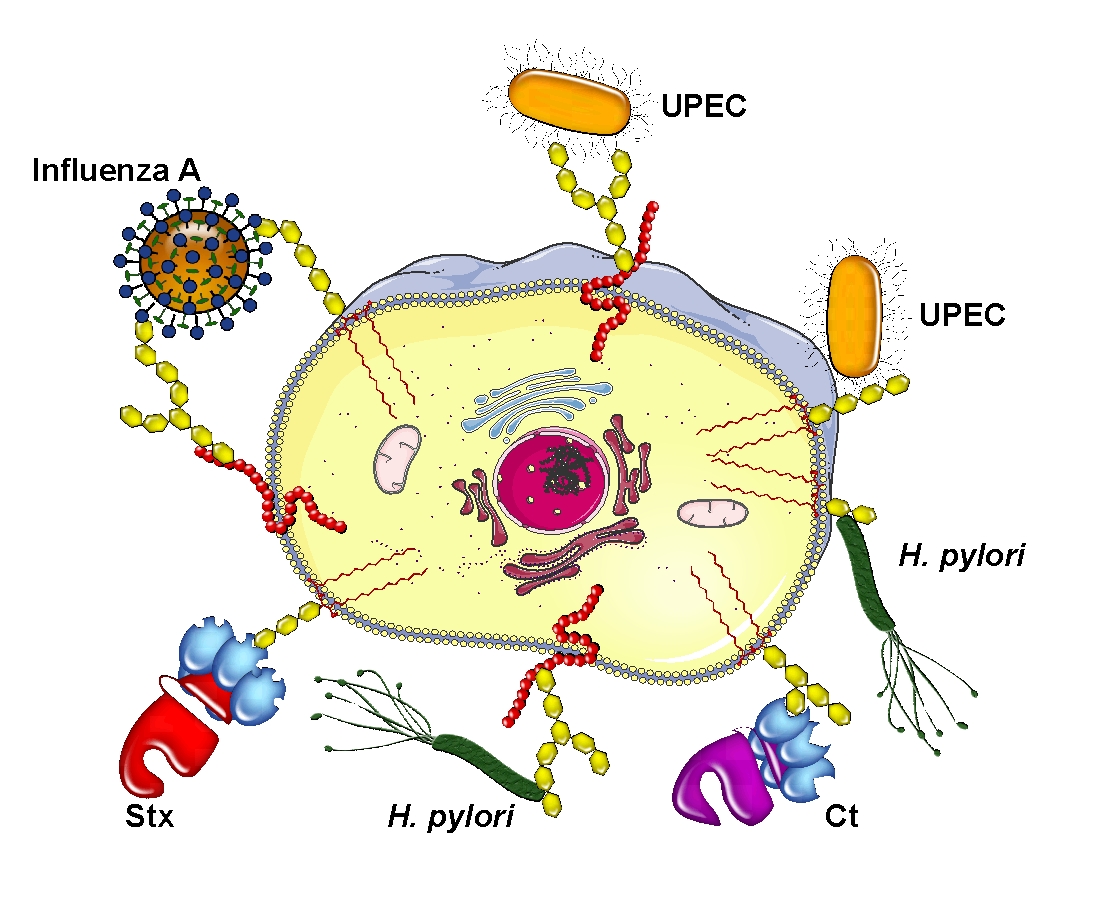Enterohemorrhagic Escherichia coli (EHEC) represent the human pathogenic subgroup of Stx-producing Escherichia coli (STEC), which are also named as verotoxin-producing Escherichia coli (VTEC). EHEC cause intestinal infections associated with watery and bloody diarrhea, which may result in manifestation of hemorrhagic colitis and life-threatening hemolytic-uremic syndrome (HUS). Extraintestinal complications of EHEC-infections are due to released Stx subtypes Stx1a and/or Stx2a which preferentially injure microvascular endothelial cells of the kidney and the brain. Therefore, studies on the functional impact of the Stx receptors globotriaosylceramide (Gb3Cer) and globotetraosylceramide (Gb4Cer) build the research focus of our work group. Structural elucidations of Stx receptors are performed in tight cooperation within the Institute for Hygiene with the work group of Professor Dr. Klaus Dreisewerd (Biomedical Mass Spectrometry) using state-of-the art mass spectrometric MALDI-TOF MS procedures (SYNAPT G2 HDMS) and ESI-Q-TOF MS technologies (Dr. Michael Mormann) combined with immunochemical techniques. Employing these MS strategies we were able to identify the Forssman-GSL as a novel Stx receptor, which is specifically recognized by Stx2e subtype.
Based on the dogma of functional requirement of supramolecular organization of GSLs in lipid rafts with regard to binding and internalisation of Stx, we thoroughly analyse the GSL composition of plasma membrane microdomains prepared from microvascular endothelial cells. In a translational research approach together with Professor Dr. Dr. h. c. Helge Karch our work group is currently investigating the potential of plant-derived Gb3-oligosaccharides or structurally homologous oligosaccharides for inhibition of Stx receptor-interaction and neutralization of the cell-damaging effect of Stx.
Due to uncertainty, which Stx receptor-carrying leukocyte subpopulations could act as transporters of Stx from the gut through the circulation to renal and cerebral endothelial cells, we are working on this issue. The complexity of the situation is increasing by the fact that Stx receptors Gb3Cer and Gb4Cer are present as lipoprotein-associates in human blood suggesting that lipoproteins could be involved in the transportation of Stx in the bloodstream and its transfer to the microvascular endothelium.
Because of their high cytotoxicity, Stxs are potential candidates for a personalized anti-tumor therapy. The application of Stx and/or Stx derivatives for a number of tumor entities of the human gastrointestinal tract, which express enhanced concentration of Stx receptors compared to unaffected tissue, seems very promising.
Although the impact of neuraminic acids on the infection of cells such as epithelial cells of the lung by influenza A viruses is known for a long time, there is vast need for research regarding the identification of cell-specific receptors, which might give some indication of host tropism and course of virus infections. We could show, for example, that human H3N2 influenza A viruses interact with sialyl-Lewisx-structures. This finding indicates that beside neuraminic acid additional substituents like fucoses may be involved in binding of viral hemagglutinins and thus in influenza infection. In this context we will conduct further work on the identification of neuraminic acid-harbouring GSL receptors (gangliosides) of influenza A viruses of human and animal origin with emphasis on zoonotic aspects.
Our research projects are financially supported by the Interdisciplinary Center of Clinical Research (IZKF) of the Medical Faculty of the University of Münster, the German Research Foundation (DFG) and the Federal Ministry of Education and Research (BMBF).


